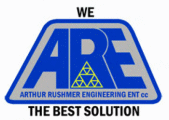
Contact Details:
Arthur Rushmer Engineering Ent cc
11 Beryllium Rd
Alrode
Alberton
Gauteng
1454
South Africa
Tel: +27 11 9084169
Fax: +27 11 8641588
Send Enquiry | Company Information

Air system service and maintenance: penny wise is pound foolish
Service News Monday, September 27, 2010: Arthur Rushmer Engineering Ent cc
Kevin Rushmer of Arthur Rushmer Engineering is quite emphatic: trying to save money by reducing compressor and air system maintenance boosts electricity consumption, increases maintenance costs and compromises the life expectancy of pneumatic equipment.
The myths:
* Extending the intervals between compressed air system servicing saves money.
* Fixing air leaks often is not worth the expense.
Compressed air, along with electricity and hydraulic systems, is an essential means of reticulating energy in a modern industrial enterprise. Rushmer says that in South Africa around 10 to 15% of power generated is used to compress air. While this may be a surprise to some, the facts behind the true cost of air power can be even more surprising.
Service intervals
Consider a 22 kW compressor operating a two-shift (4000 hours per year) application. With electricity charged on average 25 cents per kWh, the average running cost of the compressor is R28 300 per year if no breakdowns occur. This assumes that the compressor is serviced three times a year at a cost R2100 per service, incurring an annual servicing expense of R6300.
By reducing the number of services to two per year, an apparent R2100 annual saving can be made.
In reality, allowing the compressor to run un-serviced for an additional two months, twice a year, has a dramatic effect on electricity consumption. Dust begins to clog the pre-filter, air-intake filter, oil filter and the air/oil separator. This clogging is cumulative and gives rise to a decrease in performance, and an increase in electricity consumption. For every 1 kPa of clogging, efficiency is reduced by 1%.
The snowball effect of the clogging in these two-month periods can cause significant pressure drop, equivalent to a 15% reduction in efficiency over a one year period. Consequently, reverting to two compressor services per year, results in an increase of R3300 in annual electricity consumption cost. Servicing the compressor three times a year instead of twice will thus actually save the user R1200 per year. More importantly, the lifespan of the compressor components is increased, and the chance of breakdown and the consequential downtime and repair costs are reduced.
Air leaks
The opportunity to save energy and money is not limited to the compressor itself. It is not uncommon to find multiple air leaks in the compressed air pipe work of any given medium-sized industrial facility.
The cost of producing this wasted compressed air is often considered less expensive than the cost of fixing the leaks. The time and cost of hiring a pipe fitter, approximately R2800 per day, to locate and mend these leaks often deters businesses from addressing this problem.
While this remedial work sounds expensive, a quick calculation would suggest otherwise.
From studies by the International Sustainable Energy Development Authority (SEDA) the cost of a 1 to 3 mm diameter compressed air leak can be shown to waste R9200 worth of compressed air per year (based on 700 kPa air pressure, operating 6000 hours per year, with electricity charged at 25 cents per kWh). Six such air leaks will incur an annual cost of R55 200. By contrast, a pipe fitter could be expected to repair all six air leaks in one day, at R2800. This equates to a payback period of just over 2,5 weeks, and an annual return on investment of 1957,5%. The total annual saving of fixing these leaks would be R52 400.
Conclusion
Poorly maintained compressed air systems negatively impact on the environment and can have a significant impact on a company's bottom line profit. Extending periods between compressor services and neglecting compressed air leaks results in increased operating and repair costs, shorter component life and a greater risk of production losses. Regular servicing and predictive maintenance are the most efficient means of compressed air system upkeep, and yield lucrative economical benefits.
The figures used in calculations are illustrative approximations. Actual cost/benefits will vary from application to application.
